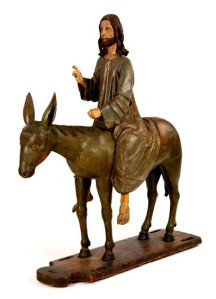In the middle ages in what is now Germany and its neighbouring lands it was the practice to process into church on Palm Sunday with a carved figure on wheels representing Our Lord riding a donkey. This was the Palmesel. It is first recorded over a millenium ago in the later tenth century.
The history of the custom and the extent of surviving examples, together with links to other resources and examples, is set out by medieval.eu at The Story of Christ on a Donkeyand the Medieval Palmesel
Here are some surving examples:
Late fifteenth century linden wood from south Germany, possibly Swabia.
Musée de Cluny Paris
Image: Wikipedia
An Austrian example from circa 1450 now at the Chazen Museum of Art University of Wisconsin-Madison
Image: Wikipedia
There is a bit more about this figure at Christ Riding a Donkey (Palmesel) (1 of 2) - UWDC - UW-Madison Libraries
The Metropolitan Museum in New York has at least two examples - one if featured in their online catalogue at Palmesel | German | The Metropolitan Museum of Art
The Victoria and Albert Museum has a Palmesel which is described at Christ on an ass | Unknown | V&A Explore The Collections

‘Christ on the Ass’, c. 1480. Limewood and pine, painted and gilded. Southern Germany. Victoria and Albert Museum, London.
Image:jasongoroncy.com
The Walters Museum in Baltimore has a late fourteenth century example which is illustrated and described in Palmesel | The Walters Art Museum
The Historisiches Museum in Basel has five examples and they and the tradition are discussed at Collection: Object description
In the museum at Schnütgen is a fine example in lime wood, softwood and polychrome which was made in Cologne circa 1520. It can be seen at https://picryl.com/amp/media/christ-upon-the-donkey-for-the-palm-procession-cologne-c-1520-limewood-and-245732
The museum in Kraków also has an example and the website also discusses the custom in an article at Jesus Christ Sitting on the Palm Sunday Donkey
Polish Palm Sunday ceremonies are discussed in an academic article from Western Michigan University at viewcontent
In southern Europe the tradition survives in Spain in the processions of Santa Semana but I am not aware of medieval examples surviving - the ones I have seen illustrated appear in a splendidly Baroque form.




No comments:
Post a Comment